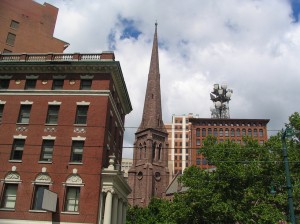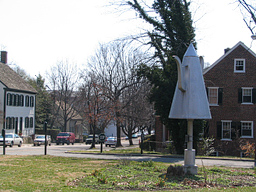
The urban density of downtown Buffalo (with a church by Richard Upjohn and Sullivan’s Guaranty Building in the background) makes Buffalo a true green city.
Today I launch my new firm and a new phase of life, combining two blogs “True Green” and “Cities & Memory”. I remember that one of the first blogs I wrote for the National Trust was an evaluation of the amount of carbon I used driving home from DC to Buffalo for Thanksgiving. And my conclusion was that no matter which way you looked at it, driving or flying, I was using a lot of carbon. But what’s the alternative? Become a hermit and never leave my apartment or see the people I want to see? There needs to be a balance.
My definition of balance is pretty warped compared to most people. Right now I literally have 3 addresses (Buffalo, Winston-Salem, NC and Washington, DC). My goal is to trade in DC for Buffalo eventually but it still only brings my cities down to two. But with confirmed projects in all three places,
I’ll still be on the road as the itinerant green preservationist I’ve become. And how green can I be continually traveling between three cities? At least they’re urban environments and all my living arrangements make use of the density that every green practitioner aspires to. Whether it’s walking to my gym from our house in Old Salem, taking the Metro in DC or walking my sister’s dogs along the Olmsted-designed parkways in Buffalo, I may be driving to get to these cities, but at least I can use my feet and public transit once I arrive.
Well, if I thought about it too long I’d never accomplish anything. So I’ve decided that being as resource-conscientious as possible in every other thing I do – whether it’s choosing materials and products for our new office in an existing warehouse to advising my clients on the best way to green their businesses – is how I will balance my carbon-heavy multi-city life. And that’s why “greening what’s already here” is BAC/A+P’s tagline.
The construction and operation of buildings accounts for almost 50% of greenhouse gas emissions in the United States. But reusing and retrofitting our existing buildings can reduce these emissions dramatically. From the simple action of preparing a National Register nomination, to developing a regulatory review mitigation plan, to preparing a sustainability master plan, to designing a LEED certified rehabilitation – these are all green building practices because they help keep what’s here and in doing so, avoid new impacts.

The roadside “coffee pot” welcomes visitors to Old Salem, where everything is within walking distance of our house.
In many respects, historic preservation methodologies are just sound, common-sense approaches to protecting the resources, culture and heritage of our planet and that is inherently sustainable development. And this methodology can be used on a National Historic Landmark or a contemporary shopping mall. There are many ways to make your building or site greener, through green housekeeping recommendations or capital improvements. Why choose to be more environmentally conscious? Because not only is it good for the planet, it’s sound business practice. When you improve your efficiency and resource use, you improve your bottom line by providing more funding for your core missions and that’s just good for everyone.
And if you’d like to “subscribe” or follow this blog, True Green Cities, please sign up through the “Subscribe” button at the bottom left of this page. You’ll receive a daily recap when new blogs are posted.

Kudos! What a neat way of thkining about it.